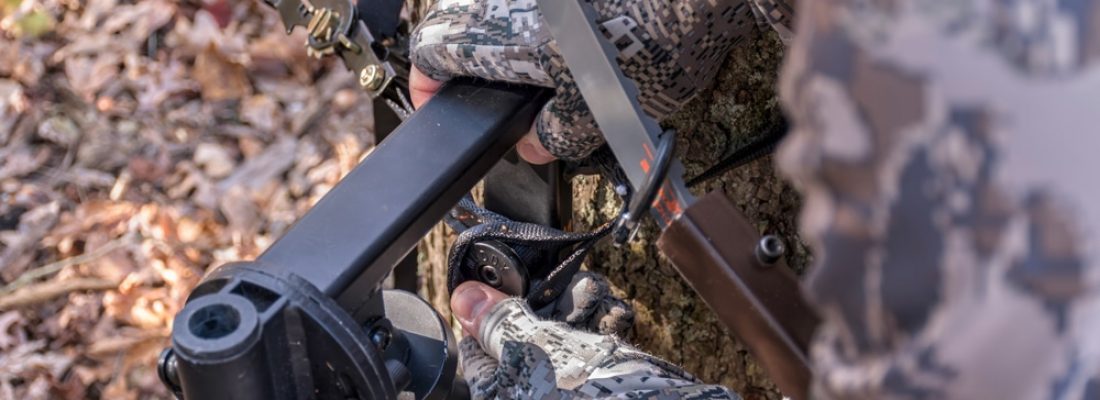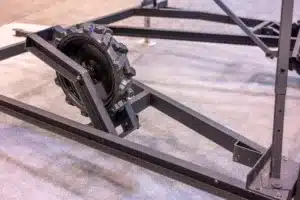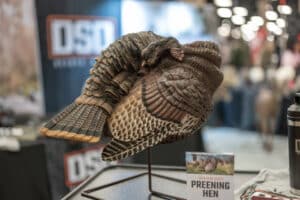No products in the cart.

365 Archery 3D Archery Targets
When folks enter a new industry, or even a new subsection of their industry, they usually dip their toe in by offering one or two


For those new to the hobby of self-filming your hunts, the added challenge of all of the extra gear to carry, set up and use can be a little daunting at first. However, after several years of self-filming I’ve developed a system that helps me stay quiet and efficient, even while setting up in the pitch-black morning hours.
First, and most importantly, is organization in your pack. Personally, I had to upgrade to a Badland’s SuperDay pack in order to house all of my gear, even for a morning hunt (I might over-pack just a tad). I like to keep my camera arm base easily accessible on the outside of the pack, lashed on with my compression straps given it is often the first thing I attach to my tree (after my fall arrest system, of course). I will often keep the ratchet strap that secures the base to the tree in the same side-pocket of my Badland’s pack as my tow-rope so I remember to put it in my pant cargo pocket when I’m at the base of the tree.
Place the pivot point/horizontal portion of the base at seat level and approximately the two o’clock mark on the tree as you are sitting in the stand (ten o’clock for a lefty). This not only enables you to control and view the camera with your bow in hand, but also allows you to shoot over your camera arm should the game approach from your camera side. With a standard length camera arm you are also able to video around your body to the offhand side if needed.
My camera arm and Manfrotto fluid head also are attached external to my pack by compression straps. Part of this is for accessibility, but the main reason is that they are too large to easily fit into most packs. The arm is then mounted to the base and a quick bubble-level check is performed before any weight is added to the arm.
I keep all of my camera equipment (secondary view GoPro with battery packs, main camera, shotgun mic, etc.) in the top portion of the main compartment on my pack. This allows for easy accessibility for charging, footage download and setup when in the stand. After you’ve attached your camera to the fluid head, make sure you adjust the drag on your fluid head so that your camera does not automatically pull up (or down) when you let go to draw. You should have just enough drag so that your camera will not move when released, but should be easy enough to pan and move the camera up and down without much effort. Also, DO NOT FORGET TO TURN ON YOUR SHOTGUN MIC. It seems like 9 times out of 10 I remember to turn it on, but it is only when I forget that I end up getting a shot. If you do happen to forget to turn it on, you can still use the footage to determine shot placement.
After my main camera is set up I will strap-on or screw-in my secondary cams to the tree. I have had the privilege of having a custom GoPro battery pack that will allow my GoPro to film for about 24 hours straight for a few years before commercial extended batteries were readily available. Nowadays, you can get a relatively cheap, and much smaller alternative from suppliers such as (Limefuel, Wasabi, Re-fuel and a few others) for less than $100. As we’ve recommended before, you’ll want to have at least one secondary angle camera directed on you, showing you controlling the main camera, grabbing your bow, etc. I’ll typically mount an additional GoPro on my bow’s riser as well for a good draw/aim view. Extreme Outdoors makes a rock-solid aluminum version that works quite well and doesn’t break the bank. Once all my camera gear is in place, I’ll setup my bow holder and hang my bow.
When the moment of truth comes, it is everybody’s first instinct to watch your quarry and not the viewfinder of the camera. Fight this urge if at all possible! Not only does this make it difficult to quickly get the animal in frame and in focus when your quarry stops in a shooting lane, but you will also miss out on precious approach footage that you won’t get a second chance to obtain.
Most importantly—even if you have had multiple seasons of self-filming under your belt—practice, practice, practice your setup before season. What I find effective is to sit a lawn chair in front of a tree in my yard and practice as if I were in the tree stand. This will allow you to fine-tune your pack arrangement in the daylight instead of fumbling in the dark on opening morning. Self filming isn’t easy by any means, but when you are able to get all the pieces to come together, you’ll be glad you put forth the extra effort!

When folks enter a new industry, or even a new subsection of their industry, they usually dip their toe in by offering one or two

Highlights of Greylight’s new releases for 2024 – the Daybreak Blind, Transformer Tower, and Nomad trailer.

With one of their coolest decoys to date, the NWTF floor was buzzing with talk of the new DSD Preening Hen decoy. It’s almost TOO
Don’t miss a thing! Subscribe below to keep informed on everything that’s happening with the folks at SELFILMED.com